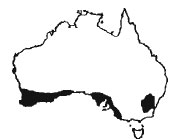Varanus Rosenbergi
Mertens 1957Rosenberg's goanna
 |
Rosenberg's goanna is similar in appearance to V.gouldii and V flavirufus but is darker in colour (those from islands tend to be darkest), has a less distinct pattern and usually has a plain. dark tail tip. rather than a light or banded tip as is found in the other species. On some islands (including Kangaroo Island) the tail tip is banded rather than plain (Houston & Tyler 1979).
In areas of Western Australia where they are sympatric with V.flavirufus the two races do not interbreed. prompting Storr (1980) to elevate them to a separate species. Hatchlings of Rosenberg's goannas are far more colourful than the juveniles of closely related species. They have an almost blue ground colour, with bright orange markings on the sides of the head, flanks and tail (see Green & King 1993). Rosenberg's goannas may reach a larger size than V.flavirufus, and tend to be more bulky. Maximum size in Western Australia is given as 103cm TL (Storr 1980). According to Tyler et at (1979) they can reach a length of 150cm on Kangaroo Island. The artimals are significantly larger on Kangaroo, Reevesby and Spilsby Islands than on the mainland. In all populations males grow about 12% longer than females (Storr 1980; Case & Schwaner 1993). Around Sydney they reach at least 50cm SVL (Shea 1994).
Rosenberg's goanna eats a wide variety of animals. They will take larger mammals such as adult possums (either alive or as carrion) (Waite 1927 in Houston & Tyler 1979). Overton (1987) reports an attack on a young echinda. Usually they are said to feed on insects, spiders, scorpions frogs, snakes, lizards, small birds and small mammals (Houston & Tyler 1979). King & Green (1979) found that mammals (especiaUy rodents) and invertebrates (roaches, orthopterans, spiders, scorpions, beetles, centipedes and moUuscs) account for two-thirds of all food taken on Kangaroo Island. The remainder of the diet is made up of frogs, reptiles, lizard eggs and birds. A 770g specimen examined by Losos & Greene (1988) contained orthopterans, lepidopterans and the remains of a mammal.
Rosenberg's goanna appears to do a lot of digging. They encounter much of their food below ground and dig enormous burrows. Tubb (1938) describes very long (over 9m), shallow (less than 30cm), forked burrows dug on the Banks Islands. Green & King (1979) found that burrows used in the surruner on Kangaroo island were much shallower than those used during the winter but shallower than those on the mainland. On Kangaroo Island the goannas may remain active throughout the winter, whilst the activity of those on the mainland is greatly reduced. Males are more active than females, and therefore encountered more often. Breeding occurs during early summer. Where tennite mounds are available they are used as nests. Eggs laid in February hatch 6-7 months later (King & Green 1979; King 1980). Ehmann et al (1991) provide an account of nesting behaviour and incubation conditions.
Several years ago there were proposals to eradicate Rosenberg's goanna from Reevsby Island to allow reintroduction of the almost extinct sticknest rat. It was claimed that the goannas had been introduced to several of the Banks Islands in the 1920s or 1950s to destroy the tiger snake population (Mirtschin 1982; Minschin & Jenkins 1985). This was refuted by Schwaner (1985) who suggested that the claims that the goannas were not native to the island were entirely speculative. Robinson et al (1985) argued that early visits to the islands had shown no evidence of goannas and that their removal was essential to allow the reintroduction of sticknest rats. Permission was given to destroy the goannas, but in the event the population proved so small that it was not worth eliminating and the scientists contented themselves with the extermination of feral cats (Schwaner pers.comm. Robinson pers. comm.).
I can find no published reports of captive breeding in this species. They should be housed in the same manner as for other large, burrowing goannas. An extremely informative and engaging account of Rosenberg's goanna is given by Green & King (1993).
Attribution / Courtesy: Daniel Bennett. 1995. A Little Book of Monitor Lizards. Viper Press U.K.




